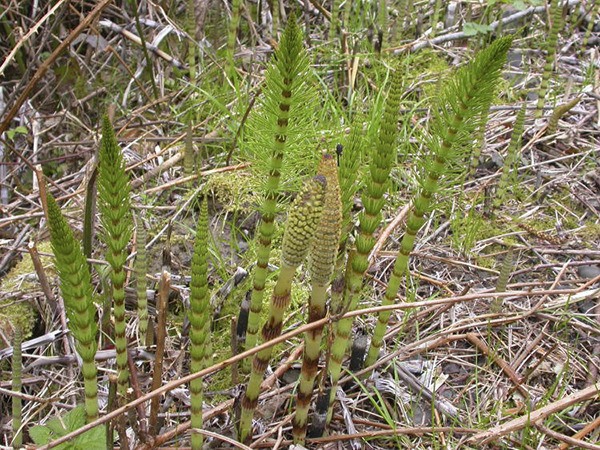Appearing now in your local area! Common or field horsetail is an aggressive perennial with a spreading rhizome system. Field horsetail does not produce flowers or seeds. This plant reproduces by spores and more commonly by creeping rhizomes and tubers.
Horsetail prefers poor drainage areas or areas with high water table; however, once established it can grow in dry areas and will grow in any type soil.
The rhizome is brown and has small tubers. In the spring two types of stems emerge from the rhizome system; both stems are hollow except at the nodes. Fertile stems grow to 6 to 8 inches in height, are tan in color, jointed and unbranched, with an inch-long spore-bearing cone at the tip. Sterile stems at maturity are 12 to 18 inches in height, green and slender, with green whorls of leafless four-angled, fine branches at each joint. Sterile stems die back in the fall. Both stems are tough to the touch because they accumulate high concentrations of silica.
Horsetail spreads by spore distribution and rhizome growth. Brushing against a fertile stem emits a cloud of spores that is carried by the wind; these spores develop into new plants. New horizontal rootstocks develop at 12-inch intervals on the rhizome. Root systems are laterally extensive and can be 5 feet deep! Segments of roots that are broken off and scattered begin to grow into new horsetail patches.
The plant can be weakened by digging up the rhizome; however, all pieces of the rhizome must be collected and disposed of to prevent spreading the horsetail.
Cut and destroy the fertile stems before spores develop and distribute. Persistent removal of the tops of horsetails about three weeks after they emerge, for three or four years, results in relatively good control.
Control of this weed is difficult because of the high level of food reserves stored in the roots and its ability to spread by both spore distribution and rhizome growth.
Giant Horsetail (E. telmateia) is very similar in appearance to field horsetail but is taller with more and larger fertile stems appearing in the spring. Giant horsetail spore-bearing cones can be up to four inches in length. Scouring rush (E. hyemale) has only fertile stems. All stems of scouring rush are green, unbranched and produce small cones at the tips. Stems can grow to 4 feet in height and frequently remain green throughout the year.
All species of horsetail are poisonous to animals, particularly (and ironically) to horses, when eaten in large quantities. All species are difficult to control.
Many of horsetail’s ancestors grew as prehistoric trees (30 MYA) and contributed greatly to the formation of coal beds. Petrified pieces of prehistoric horsetail stem measure approximately 3 inches diameter. Horsetail of today is a nuisance and difficult to control, but at least it no longer grows to such a large size!
Be persistent in your efforts to control aggressive and toxic horsetail. Over time the plant will weaken and you will get it under control!
Judy English is a Washington State University-certified, Clallam County Master Gardener.


